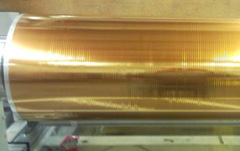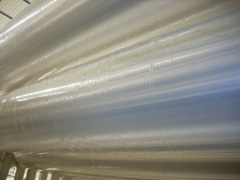Eliminating Tin-Canning Rings on Your Wound Rolls
- Published: January 25, 2013
Question: Why does my roll look like a soup can. i.e., with evenly spaced buckled rings running in the machine direction?
Answer: This defect is also called machine direction (MD) buckles or tin-canning.
 What do we know about this defect? Not much, but we are trying.
What do we know about this defect? Not much, but we are trying.
In the respected, published winding book by David Roisum and Dr. James K. Good (Winding: Machines, Mechanics, and Measurements), they devote about two pages to tin-canning. Most of the text defines the mechanism, and only brief advice on reducing tin-canning is mentioned.
One recommendations is to "reduce the tightness of the roll by decreasing any or all of the TNT (i.e. Tension, Nip, Torque) controls or by increasing speed."
 This last recommendation seems the wrong direction to me, since air escape is one of the key mechanisms of tin-canning formation, and increasing speed will increase entrained air and subsequent air escape over storage time. This point is made later in the Roisum-Good winding book, where they cite work by Al Forrest of DuPont who proposes that air escape is a mechanism of tin-canning. But Roisum-Good go on to say: "We have wound roll models that account for air escape, but currently they have not been used to study buckled roll defects."
This last recommendation seems the wrong direction to me, since air escape is one of the key mechanisms of tin-canning formation, and increasing speed will increase entrained air and subsequent air escape over storage time. This point is made later in the Roisum-Good winding book, where they cite work by Al Forrest of DuPont who proposes that air escape is a mechanism of tin-canning. But Roisum-Good go on to say: "We have wound roll models that account for air escape, but currently they have not been used to study buckled roll defects."
Still more published literature offers more advice. According to Bill Hawkins, in his book The Plastic Film and Foil Web Handling Guide, he presents a theory for tin-canning, especially tin-canning that forms in a less than full roll width band. He theorizes that tin-canning forms between two high gauge bands. The unsupported thinner web between hardbands will more easily compress to lower radial position, giving up MD strain, and from the Poisson's effect, attempt to recover width loss. Pinned between the hardbands, the width recovery can only lead to compression and buckling. Bill recommends several things to reduce tin-canning, all based on this theory aimed at reducing the radial variations in a roll, including better gauge control, gauge oscillation, or lower stack modulus through increased product roughness. He also proposes spreading immediately upstream of winding and ultra small diameter winding nip rollers.
 Overall, here is a list of how I approach tin-canning in rolls:
Overall, here is a list of how I approach tin-canning in rolls:
- Tin-canning is closely linked to width recovery and the Poisson's effect. All efforts should be aimed at reducing the width contraction upstream and into winding and prevent width recovery in the wound roll.
- Low handling and winding tensions reduce width contraction. Think of tension in terms of stress. Thinner webs will need proportionally lower tension, or they will have more strain and width contraction. For softer films, visco-elastic effects may mean lower tension upstream of winding and may also reduce tin-canning.
- Nip load reduces entrained air and width recovery from air compression or escape. Excessive nip loads may not be beneficial, since nip also increases wound-on tension (WOT) and width contraction. High nip loads may also promote nip roller deflection and more air allowed into the center of the winding roll (where tin-canning is forming). Theory would suggest a small diameter nip roller would reduce air with lower loads and less WOT and width contraction. However, a small diameter nip roller may need an extremely stiff design or have a large back up roller to prevent deflection and uneven nipping.
- A grooved rubber winding nip roller may also work in the right direction, minimizing entrained air, but since the rubber grooves allow some lateral strain in the winding nip point there is less nip-induced tension for a given nip load. Some thin webs will be intolerant of grooves in a winding nip, forming coined or indented patterns whenever the winding roll diameter is an integral of the winding nip diameter.
- Ensure no wrinkles are entering the winding roll. Wrinkles are like thin gauge bands, they allow more air in the roll that will more easily compress and encourage width recovery.
- Evaluate tin-canning at lower speeds. Less air in means less roll changes from air escape.
 Tin-canning is a strange defect. I wish I felt I knew enough to tell you confidently when they form and when they don't. I expect in many cases that changes in winding conditions and roll geometry can be helpful, but when you have the wrong combination of product thickness, low modulus, and stack properties, then certain crossweb thickness profiles will doom you to MD buckles and soup cans in your roll inventory instead of your kitchen cupboard.
Tin-canning is a strange defect. I wish I felt I knew enough to tell you confidently when they form and when they don't. I expect in many cases that changes in winding conditions and roll geometry can be helpful, but when you have the wrong combination of product thickness, low modulus, and stack properties, then certain crossweb thickness profiles will doom you to MD buckles and soup cans in your roll inventory instead of your kitchen cupboard.




